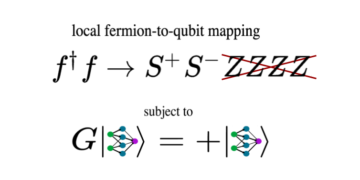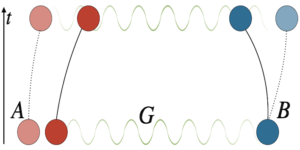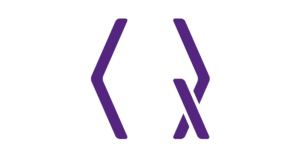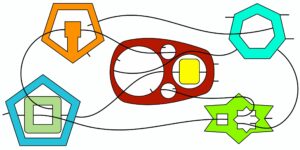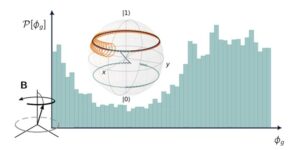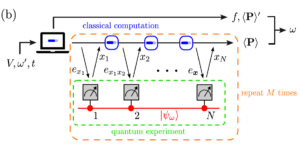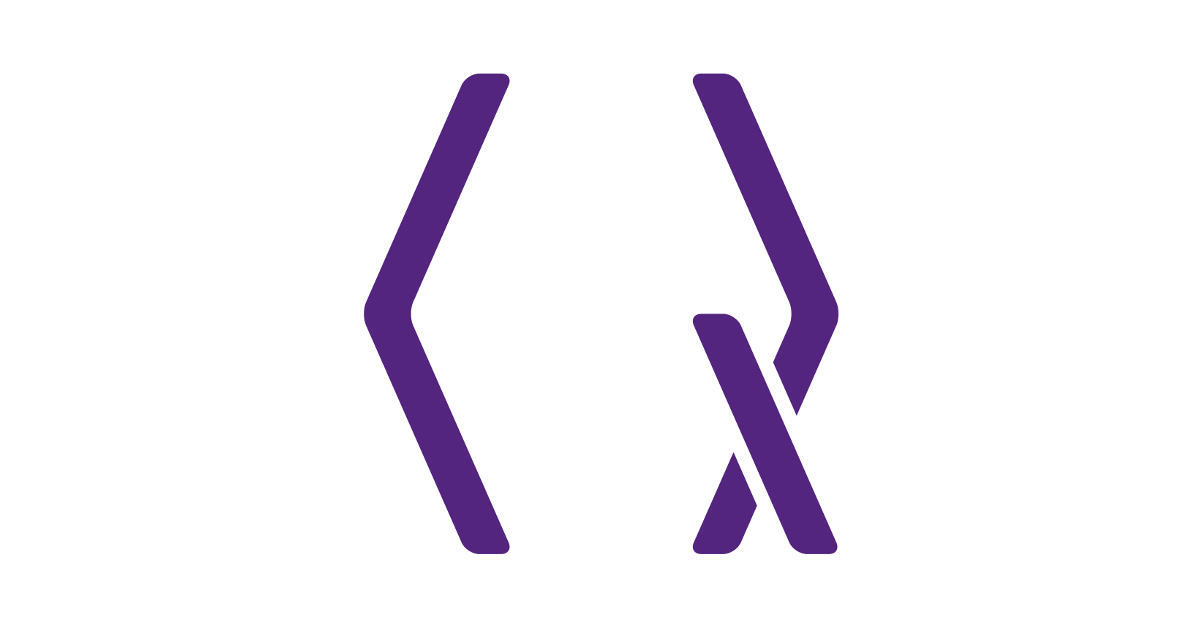
1QUANTUM, Institute of Physics, Johannes Gutenberg University, Staudingerweg 7, 55128 Mainz, Germany
2Institut Quantique and Département de génie électrique et de génie informatique, Université de Sherbrooke, Sherbrooke, Québec, J1K 2R1, Canada
Find this paper interesting or want to discuss? Scite or leave a comment on SciRate.
Abstract
A promising approach for scaling-up trapped-ion quantum computer platforms is by storing multiple trapped-ion qubit sets (‘ion crystals’) in segmented microchip traps and to interconnect these via physical movement of the ions (‘shuttling’). Already for realizing quantum circuits with moderate complexity, the design of suitable qubit assignments and shuttling schedules require automation. Here, we describe and test algorithms which address exactly these tasks. We describe an algorithm for fully automated generation of shuttling schedules, complying to constraints imposed by a given trap structure. Furthermore, we introduce different methods for initial qubit assignment and compare these for random circuit (of up to 20 qubits) and quantum Fourier transform-like circuits, and generalized Toffoli gates of up to 40 qubits each. We find that for quantum circuits which contain a fixed structure, advanced assignment algorithms can serve to reduce the shuttling overhead.
► BibTeX data
► References
[1] J. Preskill. “Quantum Computing in the NISQ era and beyond”. Quantum 2, 79 (2018).
https://doi.org/10.22331/q-2018-08-06-79
[2] C. Figgatt, A. Ostrander, N. M. Linke, K. A. Landsman, D. Zhu, D. Maslov, and C. Monroe. “Parallel entangling operations on a universal ion-trap quantum computer”. Nature 572, 368–372 (2019).
https://doi.org/10.1038/s41586-019-1427-5
[3] P. Schindler, D. Nigg, T. Monz, J. T. Barreiro, E. Martinez, S. X. Wang, S. Quint, M. F. Brandl, V. Nebendahl, C. F. Roos, M. Chwalla, M. Hennrich, and R. Blatt. “A quantum information processor with trapped ions”. New Journal of Physics 15, 123012 (2013).
https://doi.org/10.1088/1367-2630/15/12/123012
[4] D. Kielpinski, C. Monroe, and D. J. Wineland. “Architecture for a large-scale ion-trap quantum computer”. Nature 417, 709–711 (2002).
https://doi.org/10.1038/nature00784
[5] V. Kaushal, B. Lekitsch, A. Stahl, J. Hilder, D. Pijn, C. Schmiegelow, A. Bermudez, M. Müller, F. Schmidt-Kaler, and U. Poschinger. “Shuttling-based trapped-ion quantum information processing”. AVS Quantum Science 2, 014101 (2020).
https://doi.org/10.1116/1.5126186
[6] J. M. Pino, J. M. Dreiling, C. Figgatt, J. P. Gaebler, S. A. Moses, M. S. Allman, C. H. Baldwin, M. Foss-Feig, D. Hayes, K. Mayer, C. Ryan-Anderson, and B. Neyenhuis. “Demonstration of the trapped-ion quantum CCD computer architecture”. Nature 592, 209–213 (2021).
https://doi.org/10.1038/s41586-021-03318-4
[7] J. Hilder, D. Pijn, O. Onishchenko, A. Stahl, M. Orth, B. Lekitsch, A. Rodriguez-Blanco, M. Müller, F. Schmidt-Kaler, and U. G. Poschinger. “Fault-tolerant parity readout on a shuttling-based trapped-ion quantum computer”. Phys. Rev. X 12, 011032 (2022).
https://doi.org/10.1103/PhysRevX.12.011032
[8] F. Kreppel, C. Melzer, J. Wagner, J. Hilder, U. Poschinger, F. Schmidt-Kaler, and A. Brinkmann. “Quantum circuit compiler for a shuttling-based trapped-ion quantum computer” (2022).
[9] Tobias Schmale, Bence Temesi, Alakesh Baishya, Nicolas Pulido-Mateo, Ludwig Krinner, Timko Dubielzig, Christian Ospelkaus, Hendrik Weimer, and Daniel Borcherding. “Backend compiler phases for trapped-ion quantum computers”. In 2022 IEEE International Conference on Quantum Software (QSW). Pages 32–37. (2022).
https://doi.org/10.1109/QSW55613.2022.00020
[10] M. Webber, S. Herbert, S. Weidt, and W. K. Hensinger. “Efficient qubit routing for a globally connected trapped ion quantum computer”. Advanced Quantum Technologies 3, 2000027 (2020).
https://doi.org/10.1002/qute.202000027
[11] Abdullah Ash Saki, Rasit Onur Topaloglu, and Swaroop Ghosh. “Muzzle the shuttle: Efficient compilation for multi-trap trapped-ion quantum computers”. In 2022 Design, Automation & Test in Europe Conference & Exhibition (DATE). Pages 322–327. (2022).
https://doi.org/10.23919/DATE54114.2022.9774619
[12] Xin-Chuan Wu, Dripto M. Debroy, Yongshan Ding, Jonathan M. Baker, Yuri Alexeev, Kenneth R. Brown, and Frederic T. Chong. “Tilt: Achieving higher fidelity on a trapped-ion linear-tape quantum computing architecture”. In 2021 IEEE International Symposium on High-Performance Computer Architecture (HPCA). Pages 153–166. (2021).
https://doi.org/10.1109/HPCA51647.2021.00023
[13] A. Walther, F. Ziesel, T. Ruster, S. T. Dawkins, K. Ott, M. Hettrich, K. Singer, F. Schmidt-Kaler, and U. G. Poschinger. “Controlling fast transport of cold trapped ions”. Phys. Rev. Lett. 109, 080501 (2012).
https://doi.org/10.1103/physrevlett.109.080501
[14] R. Bowler, J. Gaebler, Y. Lin, T. R. Tan, D. Hanneke, J. D. Jost, J. P. Home, D. Leibfried, and D. J. Wineland. “Coherent diabatic ion transport and separation in a multizone trap array”. Phys. Rev. Lett. 109, 080502 (2012).
https://doi.org/10.1103/PhysRevLett.109.080502
[15] T. Ruster, C. Warschburger, H. Kaufmann, C. T. Schmiegelow, A. Walther, M. Hettrich, A. Pfister, V. Kaushal, F. Schmidt-Kaler, and U. G. Poschinger. “Experimental realization of fast ion separation in segmented Paul traps”. Phys. Rev. A 90, 033410 (2014).
https://doi.org/10.1103/PhysRevA.90.033410
[16] H. Kaufmann, T. Ruster, C. T. Schmiegelow, F. Schmidt-Kaler, and U. G. Poschinger. “Dynamics and control of fast ion crystal splitting in segmented Paul traps”. New Journal of Physics 16, 073012 (2014).
https://doi.org/10.1088/1367-2630/16/7/073012
[17] H. Kaufmann, T. Ruster, C. T. Schmiegelow, M. A. Luda, V. Kaushal, J. Schulz, D. von Lindenfels, F. Schmidt-Kaler, and U. G. Poschinger. “Fast ion swapping for quantum-information processing”. Phys. Rev. A 95, 052319 (2017).
https://doi.org/10.1103/physreva.95.052319
[18] D. Maslov, S. M. Falconer, and M. Mosca. “Quantum circuit placement”. IEEE Transactions on Computer-Aided Design of Integrated Circuits and Systems 27, 752–763 (2008).
https://doi.org/10.1109/tcad.2008.917562
[19] T. Parr. “The definitive antlr 4 reference”. Pragmatic Bookshelf. (2013). 2nd edition.
[20] Riverbank Computing Limited. “PyQt5” (2020).
[21] A. W. Cross, L. S. Bishop, J. A. Smolin, and J. M. Gambetta. “Open quantum assembly language” (2017).
[22] A. Kelly. “OPENQASM 2.0 grammar” (2018).
[23] M. A. Nielsen and I. L. Chuang. “Quantum computation and quantum information: 10th anniversary edition”. Cambridge University Press. (2011). 10th edition.
https://doi.org/10.1017/CBO9780511976667
[24] D. Coppersmith. “An approximate Fourier transform useful in quantum factoring”. Technical report. IBM Research Division (2002).
https://doi.org/10.48550/ARXIV.QUANT-PH/0201067
[25] A. Shafaei, M. Saeedi, and M. Pedram. “Optimization of quantum circuits for interaction distance in linear nearest neighbor architectures”. In 2013 50th ACM/EDAC/IEEE Design Automation Conference (DAC). Pages 1–6. (2013).
https://doi.org/10.1145/2463209.2488785
Cited by
[1] Fabian Kreppel, Christian Melzer, Diego Olvera Millán, Janis Wagner, Janine Hilder, Ulrich Poschinger, Ferdinand Schmidt-Kaler, and André Brinkmann, “Quantum Circuit Compiler for a Shuttling-Based Trapped-Ion Quantum Computer”, arXiv:2207.01964, (2022).
The above citations are from SAO/NASA ADS (last updated successfully 2023-11-10 02:50:52). The list may be incomplete as not all publishers provide suitable and complete citation data.
On Crossref’s cited-by service no data on citing works was found (last attempt 2023-11-10 02:50:50).
This Paper is published in Quantum under the Creative Commons Attribution 4.0 International (CC BY 4.0) license. Copyright remains with the original copyright holders such as the authors or their institutions.
- SEO Powered Content & PR Distribution. Get Amplified Today.
- PlatoData.Network Vertical Generative Ai. Empower Yourself. Access Here.
- PlatoAiStream. Web3 Intelligence. Knowledge Amplified. Access Here.
- PlatoESG. Carbon, CleanTech, Energy, Environment, Solar, Waste Management. Access Here.
- PlatoHealth. Biotech and Clinical Trials Intelligence. Access Here.
- Source: https://quantum-journal.org/papers/q-2023-11-08-1175/
- :is
- :not
- ][p
- $UP
- 1
- 10
- 10th
- 11
- 12
- 13
- 14
- 15%
- 16
- 17
- 19
- 20
- 2008
- 2011
- 2012
- 2013
- 2014
- 2017
- 2018
- 2019
- 2020
- 2021
- 2022
- 22
- 23
- 24
- 25
- 27
- 40
- 50
- 7
- 8
- 9
- a
- above
- ABSTRACT
- access
- achieving
- address
- advanced
- affiliations
- algorithm
- algorithms
- All
- already
- an
- and
- Anniversary
- approach
- approximate
- architecture
- ARE
- Array
- AS
- Assembly
- attempt
- author
- authors
- Automated
- Automation
- baker
- BE
- Beyond
- Break
- brown
- by
- cambridge
- CAN
- CCD
- chong
- cold
- comment
- Commons
- compare
- complete
- complexity
- computation
- computer
- computers
- computing
- Conference
- connected
- constraints
- contain
- control
- copyright
- Cross
- Crystal
- Daniel
- data
- Date
- definitive
- describe
- Design
- Diego
- different
- discuss
- distance
- Division
- e
- E&T
- each
- edition
- efficient
- Era
- Europe
- exactly
- exhibition
- factoring
- FAST
- fidelity
- Find
- fixed
- For
- found
- from
- fully
- Furthermore
- Gates
- generation
- given
- Globally
- grammar
- gutenberg
- harvard
- here
- high-performance
- higher
- holders
- Home
- HTTPS
- i
- IBM
- IEEE
- imposed
- in
- information
- initial
- Institute
- institutions
- integrated
- interaction
- interesting
- International
- introduce
- JavaScript
- jonathan
- journal
- kenneth
- language
- large-scale
- Last
- Leave
- License
- Limited
- lin
- List
- May..
- methods
- Month
- movement
- multiple
- Nature
- New
- Nicolas
- no
- nov
- of
- on
- open
- Operations
- or
- original
- pages
- Paper
- parity
- Paul
- physical
- Physics
- placement
- Platforms
- plato
- Plato Data Intelligence
- PlatoData
- pragmatic
- press
- processing
- Processor
- promising
- provide
- published
- publisher
- publishers
- Quantum
- Quantum Computer
- quantum computers
- quantum computing
- quantum information
- quantum software
- Qubit
- qubits
- QUINT
- R
- random
- realization
- realizing
- reduce
- reference
- references
- remains
- report
- require
- research
- routing
- s
- Science
- serve
- Sets
- singer
- Software
- storing
- structure
- Successfully
- such
- suitable
- swapping
- Symposium
- Systems
- tasks
- Technical
- Technologies
- test
- that
- The
- their
- These
- this
- Title
- to
- Transactions
- Transform
- transport
- traps
- under
- Universal
- university
- updated
- URL
- via
- volume
- von
- W
- want
- was
- we
- which
- with
- works
- wu
- X
- year
- zephyrnet



